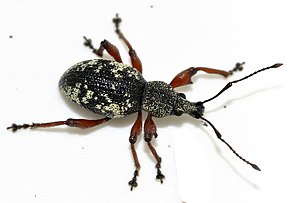Otiorhynchus lepidopterus
| Otiorhynchus lepidopterus | ||||||||||||
|---|---|---|---|---|---|---|---|---|---|---|---|---|

Otiorhynchus lepidopterus |
||||||||||||
| Systematics | ||||||||||||
|
||||||||||||
| Scientific name | ||||||||||||
| Otiorhynchus lepidopterus | ||||||||||||
| ( Fabricius , 1794) |
Otiorhynchus lepidopterus is a beetle from the family of weevils (Curculionidae).
features
The 6–8 mm long black weevils have large bright spots on their wing covers . The pronotum is spherical, the elytra are oblong-oval. The eyes are lateral and clearly outstanding. The tarsi and apical ends of the femora are black, otherwise the legs are colored red. The anterior femora have a large triangular tooth.
distribution
The occurrence of Otiorhynchus lepidopterus extends over two largely separate areas. The species occurs on the one hand in Fennoscandinavia and East Prussia . Furthermore, the occurrence of the weevil species extends across south-east Europe and the Alps . It extends to Switzerland in the west. In Germany, the species is mainly represented in the Alpine foothills and in the Harz Mountains .
Way of life
The beetle species occurs in forests in the montane and subalpine zones . The beetles can be seen from May to the end of July. They are often found on spruce trees . The beetles reproduce parthenogenetically , that is, they are presumably exclusively females.
Taxonomy
The following synonyms can be found in the literature :
- Curculio lepidopterus Fabricius , 1794
- Curculio salicis Ström , 1783
- Curculio squamiger Fabricius , 1801
- Otiorhynchus (Majetnecus) pauperculus Stierlin , 1858
- Otiorhynchus (Majetnecus) comptus auct.
In older works, the name O. salicis is mostly used.
The synonymy of the species pair O. lepidopterus / O. squamosus Miller, 1859, remains unclear . In squamosus is the sexual form of lepidopterous . According to Lohse, the two forms differ mainly in the shape of the tooth on the fore legs. In the females of lepidopterus this is large and triangular, in the females of squamosus it is smaller and spiked out, while in the males of squamosus it is remarkably large, hook-shaped curved forward and hollowed out on the underside. The picture above shows such a male. There are also subtle differences in the hairiness of the wing coverts on the crash.
There is still no agreement as to whether one regards squamosus as a synonym for lepidopterus , as in, for example, or whether one still regards them as separate species, such as in.
Individual evidence
- ↑ a b c d e Arved Lompe: Beetle of Europe - Dorymerus . coleonet.de. Retrieved February 14, 2020.
- ↑ a b c d e f g h Heinz Freude , Karl Wilhelm Harde , Gustav Adolf Lohse (Hrsg.): Die Käfer Mitteleuropas . tape 10 : Bruchidae – Curculionidae 1 . Goecke & Evers , Krefeld 1981, ISBN 3-87263-029-6 , pp. 214 .
- ↑ a b Otiorhynchus (Majetnecus) lepidopterus in Fauna Europaea. Retrieved February 14, 2020
- ↑ Muster, C. & Krause, R .: Distribution pattern of weevils (Coleoptera: Apionidae, Curculionidae) on the northern edge of the Alps. Entomologica Austriaca 6/2002; 12-13
- ↑ Alonso-Zarazaga & al .: Cooperative Catalog of Palaearctic Coleoptera Curculionoides, Monografias electrónicas SEA 8; Sociedad Entomológica Aragonesa SEA. Zaragoza, Spain, 2017
- ↑ Sprick, P., Schmidl, J .: Checklist of weevils in Bavaria (Coleoptera: Curculionidea excl. Anthribidae, Platypodidae et Scolytidae). Contributions to Bavarian Entomofaunistics 7, January 2005, 77-95
Web links
- Otiorhynchus lepidopterus at www.biolib.cz
- www.kerbtier.de
